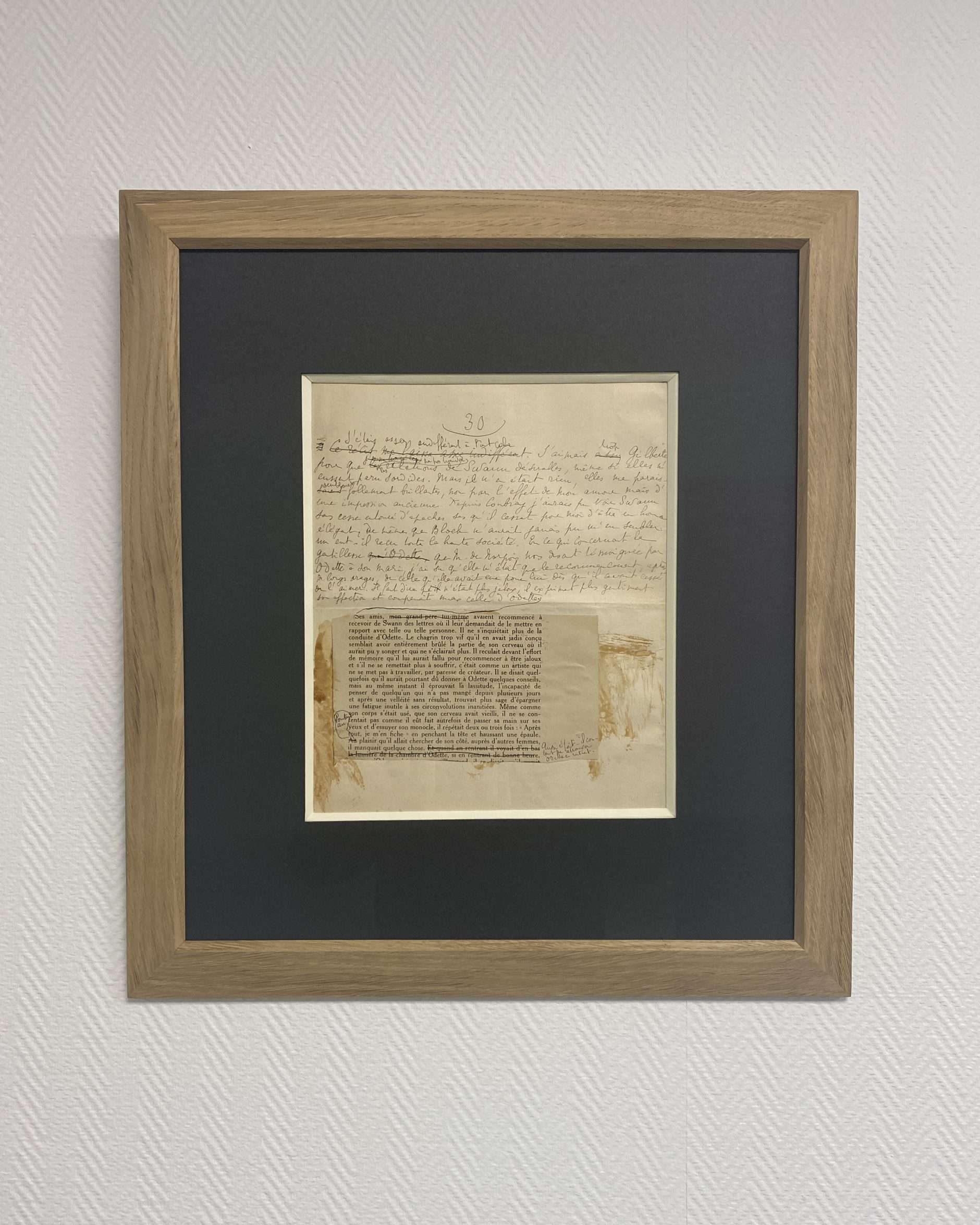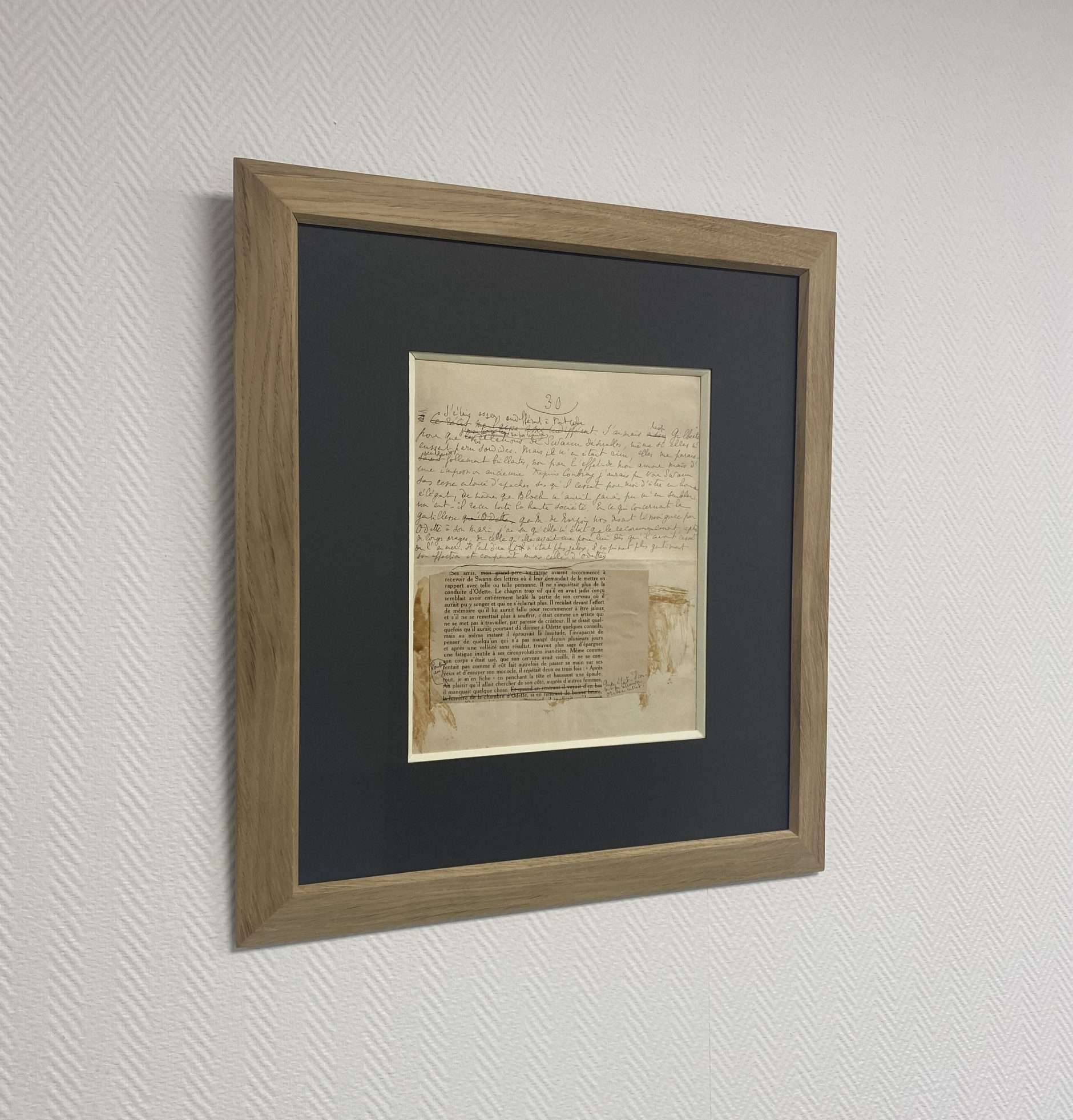PROUST, Marcel (1871-1922)
Typescript with autograph additions for the first edition of In the Shadow of Young Girls in Flower
One page in-12 oblong glued on in-4 laid paper
“I loved Gilberte too much not to find Swann’s relationships desirable”
Fact sheet
PROUST, Marcel (1871-1922)
Typescript with autograph addition for the first edition of In the Shadow of Young Girls in Flower
[Étampes, imprimerie “La Seumeuse”, pour la NRF, c. 1917]
One page in-12 oblong (7,3 x 13 cm) glued on in-4 laid paper (23,4 x 17,5 cm)
Foliation number “30”
Original glue makrs, slight tear without affecting the text
Superb manuscript fragment for In the Shadow of Young Girls in Flower, in a primitive variant, and situated in the first part of the novel
An outstanding testimony of Marcel Proust’s rewriting work during the war.
Transcription (The printed text is in Roman font and the autograph additions are in italic)
“Ce récit me laissa assez indifférent J’étais assez indifférent à tout cela. J’aimais assez trop Gilberte pour [Marcel Proust a d’abord écrit puis biffé successivement “les” puis “j’eusse trouvé“] ne pas trouver les relations de Swann désirables, même si elles m’eussent paru sordides. Mais il n’en était rien, elles me paraissaient semblaient follement brillantes, non par l’effet de mon amour mais d’une impression ancienne. Depuis Combray j’aurais pu voir Swann sans cesse entouré d’apaches sans qu’il cessât pour moi d’être un homme élégant, de même que Bloch n’aurait jamais pu m’en sembler un, eût-il reçu tout la haute société. En ce qui concernait la gentillesse qu’Odette que M. de Norpois nous disait témoignée par Odette à son mari, j’ai su qu’elle n’était que le recommencement, après de longs orages, de ce qu’elle avait eue pour lui dès qu’il avait cessé de l’aimer. Il faut dire qu’il n’était plus jaloux, il exprimait plus gentiment son affection et comprenait mieux celle d’Odette.”
Ses amis, mon grand-père lui-même avaient recommencé à recevoir de Swann des lettres où il leur demandait de le mettre en rapport avec telle ou telle personne. Il ne s’inquiétait plus de la conduite d’Odette. Le chagrin trop vif qu’il en avait jadis conçu semblait avoir entièrement brûlé la partie de son cerveau où il aurait pu y songer et qui ne s’éclairait plus. Il reculait devant l’effort de mémoire qu’il lui aurait fallu pour recommencer à être jaloux, et il ne se remettait plus souffrir, c’était comme un artiste qui ne se met pas à travailler, par paresse de créateur. Il se disait quelquefois qu’il aurait pourtant dû donner à Odette quelques conseils, mais ai même instant il éprouvait la lassitude, l’incapacité de penser de quelqu’un qui n’a pas mangé depuis plusieurs jours et après une velléité sans résultat, trouvait plus sage d’épargner une fatigue inutile à ses circonvolutions inanitiées [sic]. Même comme son corps s’était usé, que son cerveau avait vieilli, il ne se contentait pas comme il eût fait autrefois de passer sa main sur ses yeux et d’essuyer son monocle, il répétait deux ou trois fois : “Après tout, je m’en fiche” en penchant la tête et haussant une épaule. Au “Pourtant au” plaisir qu’il allait chercher de son côté, auprès d’autres femmes, il manquait quelque chose. Et quand en rentrant il voyait d’en bas la lumière de la chambre d’Odette, si en rentrant de bonne heure “Aussi était-il content de retrouver Odette en rentrant”
The fact that the current variant is so remote from the final version reveals the magnitude of the rewriting process. It is divided in two parts: The first one was not kept (or at least in a less approaching way). The second part was entirely rewritten. Proust seems to have situated them in the part of the novel during which the meal was given by the narrator’s parents to M. de Norpois, at the beginning of the Young Girls, where the conversation is lasting on Odette and Charles Swann.
“An old impression”
Afterglow. In the first part of the text, the narrator recalls the opinion he had formed himself on Charles Swann as an elegant man. A durable opinion to the point of resisting the remarks about Swann’s relationships.
“He was backing out in front of the memory effort which he would have needed in order to become jealous again”
The test of time. On the contrary, the second part underlines the heart-intermittencies with Charles Swann, describing his change of attitude towards his unfaithful wife Odette. After having been a jealous lover, he became a complacent husband: Time has done its work and faded the mutual feelings. This transformation is in fact described in the long evolution of the character during the whole novel In the Search of Lost Time: “His metamorphosis illustrate the notion, explained in Combray, of the subjectivity nature of the view of social personality (Brian G. Rogers, article “Charles Swann”, in the Marcel Proust Dictionary).
The long lasting rewriting process which Marcel Proust accomplished during the war
The composition and the publication of the Yong Girls represents a highly complex episode which lasted during several years. A first draft was given for typing in 1911-1912. In 1913 and 1914 were printed the first draft versions for Bernard Grasset (who published Swann’s Way in 1913 at the expenses of the author). Several factors led Marcel Proust to make in-depth modifications on his text: One of which was the requirements of his editor regarding the length and the layout of In the Search of Lost Time. The other factor being the war which had sensibly delayed the typing of a final draft. Eventually the working method of Marcel Proust who, from multiple readings, couldn’t stop correcting and / or amplifying his text. The volume of the Young Girls is the representative fruit of this working method, consisted mostly of countless additions and rewriting during the war.
After he left Bernard Grasset to finally join the Nrf (Nouvelle revue française) in 1916, Marcel Proust had his text re-typed as it was last written and applied a multitude of corrections, and the end of which he eventually received a new typescript in April 1918. The was no In the Shadow of Young Girls in Flower manuscript per se. It actually became this extraordinary “mapping” where multiple typescripts glued over larger sheets of paper alternate autograph corrections. Some date as far back as 1914, others were established for the 1918 publication” (P. Clarac, Bulletin des Amis de Marcel Proust, N°2).
The work was completed for print on November 1918 but was eventually published on June 1919, following which it won the Prix Goncourt on December that same year.
This corrected / amended typescript therefore most likely belongs to the first print drafts for the Nrf (Nouvelle revue française) in 1917, the one which underwent in-depth corrections. The Pléiade publishers, to this day, do not identify any examples kept in public domain. The second set of corrected typescripts, printed on April 1918, partly kept at the Bnf (Bibliothèque nationale de France) under ref. Y2 824 comprises in fact the second part of the text but in its nearly definitive variant, almost entirely different (f.76).
Mosaic manuscripts fragments for In the Shadow of Young Girls in Flower are scarce. This particular one, showing first draft variants, makes it even more precious.
Note: This corrected typescript, apparently unpublished, has not be referenced by Pyra Wise.



